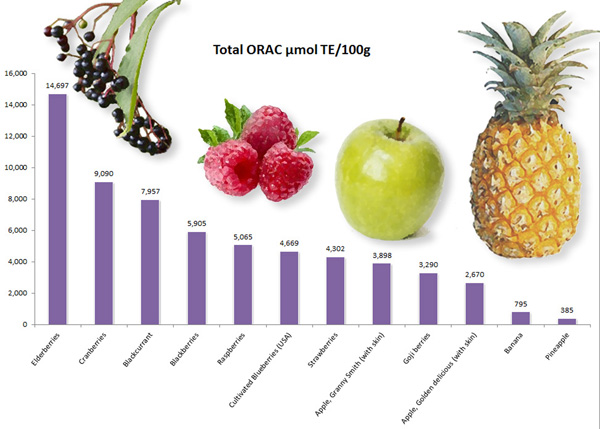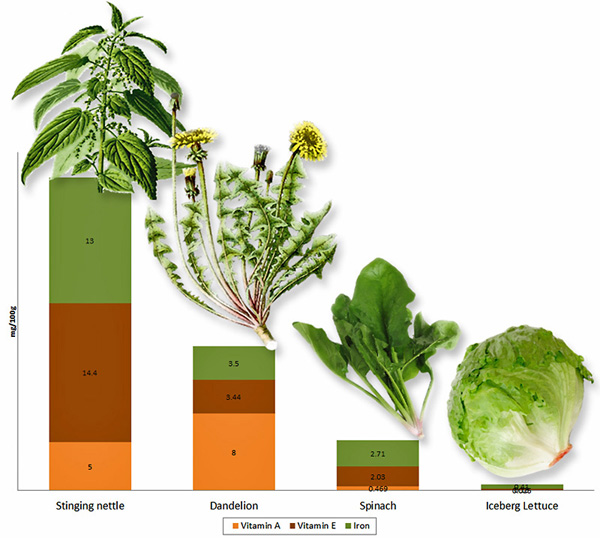Colourful food, healthy mood!
Fruit and vegetable plants are easily recognized as a rich source of vitamins, minerals, and fiber. But in the last decades a new group of nutrients made is way in our knowledge of healthy lifestyle: they are called phytochemicals, or phytonutrients, which are powerful antioxidants. The best known phytonutrients are the carotenoids, flavonoids, polyphenols, indoles, lignans and isoflavones. These are the nutrients often concentrated in the skins of many fruits and vegetables, and are responsible for their color, hue, scent and flavor.
- Which plants have the largest amount of phytonutrients?
- How does processing (such as cooking, drying or freezing) plant foods affect their phytonutrients?
- What does that have to do with wild edibles?
Phytonutrients & wild plants
Plant breeding started with agriculture, and dates back around 11,000 years. Early farmers changed their original diet, selecting vegetables more pleasurable to eat: sweetest fruits, starchy cereal grains and oil-rich plants. The consequence of rejecting bitter or fibrous food was a dramatic loss in phytonutrients. Indeed, many of the most beneficial phytonutrients have a sour, astringent, or bitter taste.
Polyphenols (phytonutrients or bionutrients) are the arsenal of chemical compound that plant use as a defence against insect, disease, ultraviolet light, etc.. When we eat them we gain protection against free radicals. If we were still eating wild plants, there would be no need to take phytonutrient extracts in pills.
Most of the humble wild plants have a lot more phytonutrients and vitamins than man-made varieties of fruits and vegetables. Although ORAC (Oxygen Radical Absorbance Capacity) values have been recently withdrawn by USDA, they can be considered a general approximation of the antioxidant potential of a food. The image below shows some ORAC values of wild and cultivated fruits, according to USDA database for ORAC, Release 2.
 The main reason of ORAC values withdrawal is that they have been manipulated ad misused by food and dietary supplement manufacturing companies, claiming high ORAC values for marketing their products. The other reason is that ORAC test it’s done in vitro, and could not have direct correlation to what happens in your body. You can find further information in this interesting article by Dr. Jonny Bowden.
The main reason of ORAC values withdrawal is that they have been manipulated ad misused by food and dietary supplement manufacturing companies, claiming high ORAC values for marketing their products. The other reason is that ORAC test it’s done in vitro, and could not have direct correlation to what happens in your body. You can find further information in this interesting article by Dr. Jonny Bowden.
So, to get back to old-fashioned and easily measurable minerals and vitamins, take a look at this! Nettle claims five times more Iron and seven times more Vitamin E than spinach. Dandelion leaves claim seventeen times more Vitamin A (carotenoids) than Spinach,and they are richer in beta-carotene than carrots!
 To top it all, in springtime wild edibles young shoots are rich in plant hormones, that can do wondrous health effects to human health. Laboratory findings show that plant hormones can have a detoxification effect and boost the body’s natural defense against stressors and diseases.
To top it all, in springtime wild edibles young shoots are rich in plant hormones, that can do wondrous health effects to human health. Laboratory findings show that plant hormones can have a detoxification effect and boost the body’s natural defense against stressors and diseases.
Phytonutrients & food processing
Food preparation affects the phytonutrients and, raw vegetables usually have more nutrients than cooked ones. There are some exceptions, like broccoli and carotenoids-rich plants:
- Cooking broccoli releases the enzyme, indole, that fights cancer. Raw broccoli loose their cancer-fighting compounds 24 hours from harvest
- Cooking tomatoes increases their lycopene bioavailability. Heat breaks down cell walls and changes the molecular structure of lycopene (from all-trans to cis-isomers, better absorbed by the body)
- Slicing carrots after cooking them whole, increases their anti-cancer properties.
- When you crush or chop garlic it releases the enzyme, allicinase, to produce the active phytonutrient, allicin.
- Most berries increase their antioxidant activity when cooked
- Dried berries loose more or less the half of their antioxidant value during the drying process. Fruits that are dried more rapidly in a hot air tunnel retain more of their original health benefits. Better use a dehydrator than slowly drying them in the sun.
- Frozen berries retain most of their anthocyanins. If you freeze your own berries, you will preserve more of their nutrients if you dust them with sugar, which slows the rate of oxidation.
Share this!